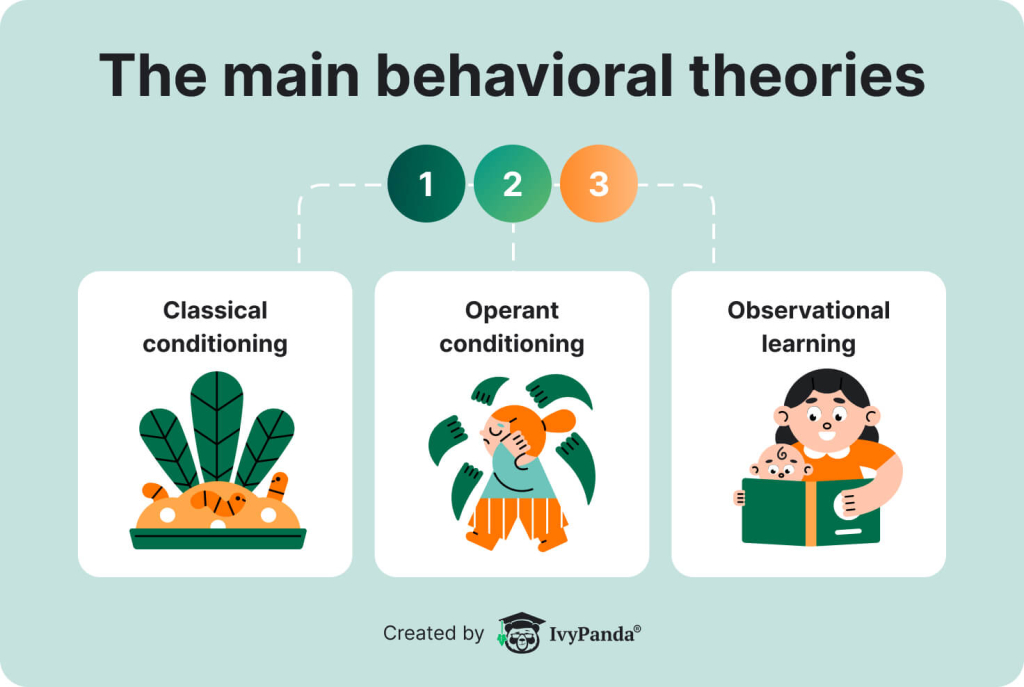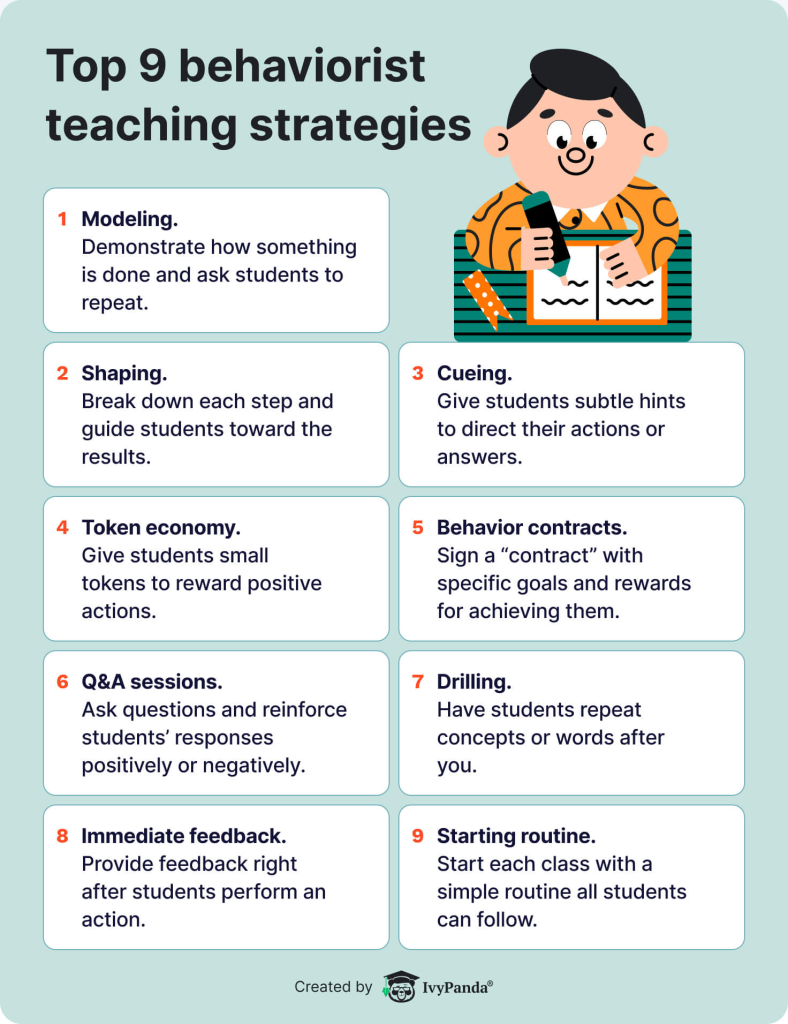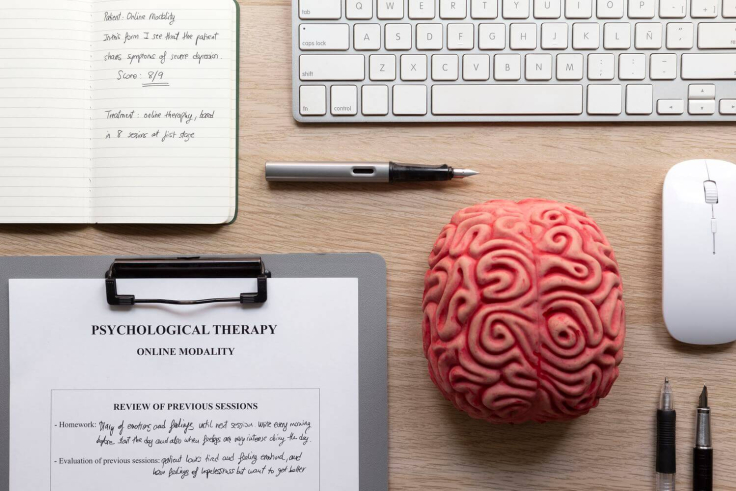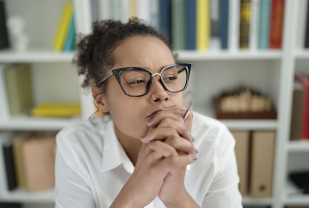Have you ever thought about why you instinctively reach for the phone when it rings or brush your teeth every morning? These seemingly simple things took time to learn, but now they’re second nature.
The process of mastering something new was once a mystery before the emergence of behavioral learning theory. This theory focuses on teaching behaviors and how the environment impacts this process. It has proven highly effective in educational settings, producing tangible outcomes.
If you’re a teacher or a student interested in this subject, this article is for you. It covers the psychology of learning, the benefits and limitations of behaviorism, and its real-world applications. You will also discover helpful behaviorist learning tips for students.
- 🎓 What Is Learning in Psychology?
- 🔍 The History of Behaviorism
- 🎯 3 Key Behavioral Theories
- ⚖️ Pros and Cons of Behaviorism
- 🏫 Applying Behaviorism in Education
- 🚀 Top 9 Teaching Strategies That Work
- 🤔 The Limitations of Behaviorism in the Classroom
- 🎁 BONUS: 9 Behaviorist Tips for Students
- 🔗 References
🎓 What Is Learning in Psychology?
Essentially, learning is the process of acquiring information, knowledge, and skills. The experience gained from learning often changes a person’s behavior.

Learning isn’t limited to formal education. People continuously learn throughout their lives, whether through personal experiences or interactions with others.
Here’s how it works:
- You get information,
- Compare it to what you already know,
- Comprehend what you’ve learned,
- Apply the new knowledge.
Experts and researchers consider behaviorism one of the leading theories for interpreting the components of the learning process.
Let’s look closer at it.
🔍 The History of Behavioral Learning Theory
The concept of behaviorism stems from the idea that learning is directly linked to behavior. The foundation of the theory was laid in John B. Watson’s 1913 paper Psychology as the Behaviorist Views It. This publication argued that all behavior results from learning.
Wilhelm Wundt, the founder of experimental psychology, significantly developed behaviorism. He was the first to initiate that psychology should be grounded in measurable experiments. Behaviorists adopted this approach, leading to concrete discoveries about the learning process.
You’ve probably heard about Ivan Pavlov’s experiments on dog conditioning – these were essential in validating behaviorist theories. Alongside Pavlov, notable scholars like B.F. Skinner, Edward Thorndike, and Albert Bandura studied learning through experiments.
Many of those studies would likely be considered unethical today. One prominent example was the “Little Albert” experiment where a child was conditioned to fear rats through a combination of stimuli.
The Legacy of Behaviorism
Behaviorism was a predominant psychological theory until the mid-1950s. During its peak, it allowed researchers develop theories with precise descriptions supported by empirical evidence. Their work has had a lasting influence on many aspects of our lives:
- Behaviorism popularized psychological testing and paved the way for further research into the psychology of learning.
- Additionally, the founders of behaviorism laid the groundwork for branches such as humanistic, biological, and cognitive psychology, which have since deepened our perception of education.
Where Behaviorism is Used
Since its introduction in the 20th century, behaviorism has found application in various fields, including:
- Education: Behaviorism helps shape the student’s learning environment and aids them in memorizing the material.
- Mental health: Psychologists use behavioral conditions to treat patients dealing with problematic thoughts and behaviors. Techniques such as discrete trial training, behavior analysis, and behavioral intervention are rooted in this theory.
- Research: Behavioral psychology allows scientists to observe and scrutinize human behavior. This approach makes it easier to quantify and collect data.
🎯 How Learning Works: 3 Key Behavioral Theories
Behaviorism has three principal theories: classical conditioning, operant conditioning, and observational learning.

Let’s take a closer look at each.
Classical Conditioning
Frequently used in behavioral training, this technique includes pairing a neutral stimulus with a naturally occurring one to elicit a reaction. Eventually, the individual responds to the neutral stimulus, even when the natural one is absent. In classical conditioning, the stimuli must appear simultaneously for the brain to link them together.
A popular example of classical conditioning is Ivan Pavlov’s iconic experiment with dogs. He trained them to associate mealtime with the bell sound. Eventually, even without food present, the animals would salivate at the sound of the bell. (A playful reference to this experiment is shown in the American version of The Office when Jim uses the method on Dwight.)
Operant Conditioning
Operant conditioning involves connecting behaviors to positive reinforcements, negative reinforcements, or punishments. It focuses on associating actions with either positive or negative outcomes, essentially teaching a person or animal about the effects of their behavior.
Here are 3 components of operant conditioning:
- Positive reinforcement involves rewarding someone for a desirable action to urge the continuation of that behavior.
- Negative reinforcement implies removing an unpleasant stimulus to ensure the intended behavior persists.
- Punishment involves introducing a consequence that decreases the likelihood of a particular behavior. Punishment can be either positive (adding something unpleasant) or negative (removing something desirable.)
Observational Learning
Albert Bandura introduced this unique method, which isn’t based on conditioning. As part of his social learning theory, Bandura argued that not all behaviors are directly linked to stimuli. Instead, observational learning occurs by watching others and imitating them.
A typical example of this method is how children learn during their early years. Parents teach them to turn over, crawl, eat solid food, and talk by setting an example.
We often use observational learning in daily life without even realizing it. For instance, people may learn how to operate a lawnmower or cook simply by watching YouTube videos.
⚖️ Advantages and Disadvantages of Behavioral Learning Theory
Like all theories, behaviorism has pros and cons, which are essential to comprehend before applying it in practice.
Here are the principal ones:
Let’s examine them in more detail.
Benefits of Behaviorism
The primary advantage of behavioral learning theory is that it reveals the previously unexplored link between behavior, stimuli, and reinforcement.
Other perks of behaviorism include the following:
- It can be used to train people, animals, and even technology, such as AI.
- The theory is solid and measurable, as its phenomena can be observed and quantified.
- It offers a strategy for learning and unlearning specific behaviors, particularly negative ones.
- Behaviorism can help replace bad habits with more productive ones, which is why it is commonly used in therapies such as those treating substance abuse.
Drawbacks of Behaviorism
Early behaviorism concentrated solely on observable behaviors, which led to its primary weaknesses:
- It neglects internal cognitive processes, feelings, and emotions.
- Behaviorism fails to account for social factors, such as class and gender, which can shape conduct.
- Some scientists, like B.F. Skinner, believed that human actions were driven only by stimuli and responses. Such radical behaviorism is an extremely reductionist view.
Behaviorism is now often paired with other theories, such as neuroscience and social cognition, to address these shortcomings and create a more well-rounded perception of learning.
🏫 Applying Behaviorism in Education
Since behaviorism emphasizes repetition, reinforcement, and rewards for appropriate behavior, it is highly suitable for the education system. This approach actually underpins many popular pedagogic theories.
Here’s how its components may be applied in various situations:
- Positive reinforcement: Students are rewarded for a job well done, encouraging them to continue putting in effort. This technique also increases the likelihood of repeating positive behavior.
- Negative reinforcement: In this case, educators remove unpleasant stimuli to promote a particular behavior. For example, a teacher can reduce the amount of homework for a learner who performed well on a test.
- Punishment: When a student engages in wrong behavior, they are disciplined accordingly. This might mean lowering a grade for submitting an assignment after a deadline or scolding a student for speaking out of turn.
What Makes It an Effective Approach?
The chief advantage of the behaviorist approach in teaching is that it discourages unacceptable behavior while supporting positive conduct.
Other benefits include:
- Managing classroom behavior and discipline through positive and negative reinforcement strategies.
- Motivating students to learn by rewarding their endeavors and achievements.
- Helping learners master self-regulation by teaching them to monitor and control their behavior.
These features make behaviorism a valuable teaching tool for subjects such as math, foreign languages, PE, and music.
Reinforcements vs. Punishments: Which Is More Preferable?
It may seem surprising, but research suggests that reinforcements are more effective than punishments. They cause less anxiety and are better for students’ self-esteem. Additionally, reinforcements are generally more successful than penalties in improving behavior.
Punishing students can make them resent or fear educators and may cause defiance. In contrast, reinforcement techniques help avoid unpleasant situations and create a nurturing educational atmosphere.
🚀 Top 9 Behaviorist Teaching Strategies That Work
Many popular teaching strategies utilize behaviorist principles. A popular example is gamification, which rewards learners for specific achievements. Outside the classroom, this approach is prevalent in various educational apps.
Here are 9 actionable techniques you can try in class:

#1. Modeling
Modeling is based on the concept of observational learning. Simply put, you demonstrate how something is done, and your students repeat the process. This can range from solving a math problem to outlining an essay or explaining the structure of a complex sentence.
#2. Shaping
Shaping works similarly to modeling but is more in-depth. Here, you gradually show how to achieve the needed results, breaking down each step. For instance, when solving a math problem, you’d guide students through each part of the process until the solution is reached.
This systematic approach also helps identify where students struggle and allows you to clarify challenging steps.
#3. Cueing
Cueing is a subtle technique that guides students toward appropriate behavior and task-solving through cues. These cues can be:
- Verbal, like reminders and questions,
- Visual, like gestures and pictures,
- Physical, like touch or movement.
The aim is for learners to pick up on these cues and understand what’s required, improving memory recall and problem-solving skills.
#4. Token Economy
This approach is commonly used in gamification and revolves around a reward system. Students earn tokens for positive actions and can exchange them for small prizes and privileges, such as finishing a class early. This provides students with a tangible incentive to perform well.
#5. Behavior Contracts
This formal technique involves both students and teachers signing “contracts” with specific goals for both parties and rewards for achieving them. Students become aware of the expectations and are encouraged to adhere to them.
This method allows all participants in the learning process to know what to expect and helps them work towards a tangible end goal.
#6. Q&A Sessions
This behaviorist method functions similarly to cueing but operates at a deeper level. Teachers respond to student answers with positive or negative reinforcement.
You can use this technique to guide learners in specific directions or to enhance their comprehension by asking probing questions. The questions can become more challenging as the sessions progress.
#7. Drilling
Drilling is the most straightforward behaviorist technique based on the repetition of concepts and examples. It helps students acquire new skills and memorize language structures. For instance, you can use drilling to teach sentence structure or vocabulary.
More complex drills can involve transforming sentences from positive to negative or integrating new words into existing sentences.
#8. Immediate Feedback
Another key behaviorist technique is providing students with immediate feedback after an action. This helps establish a clear connection between their behavior and its consequences.
If feedback is delayed, it becomes harder for the student to understand what they did right or wrong, as the details of the action may no longer be fresh in their mind.
#9. Starting Routine
Introducing a pre-class routine, such as having students answer warm-up questions or solve a brain teaser, can be a powerful technique. Praising and rewarding learners for following the routine reinforces their behavior, helping them focus and fostering a positive classroom atmosphere.
🤔 The Limitations of Behaviorism in the Classroom
Behavioral learning theory is a great approach that can be highly beneficial for teachers. However, there are a few drawbacks to keep in mind:
- It has little impact on critical thinking and problem-solving skills.
- A heavy focus on rewards can lead to extrinsic motivation, where students chase approval rather than engage in meaningful learning.
- There’s always the risk of unwanted behaviors returning once the stimuli or rewards are removed.
The key takeaway is that students need to maintain autonomy in the classroom. It’s essential to encourage them to be proactive and creative. Don’t rely too heavily on routines and reward systems since students may passively repeat what they’ve been taught.
💡 Pro tip:
If you’re a teacher, try combining behaviorism with other learning techniques tailored to your students’ individual personalities. You can learn more about helpful strategies from our comprehensive teaching guide.
🎁 BONUS: 9 Key Learning Behaviors of a Successful Student
Behaviorist strategies aren’t only helpful to teachers; students can use them to achieve better academic results, increase motivation, and reduce stress. If you’re a student, check out these top 9 strategies and try incorporating them into your daily routine:
#1. Practice Attentive Listening
Concentrate fully on the teacher’s words during class. Actively listen when others speak, whether it’s during a presentation or group work. This will help you absorb the information without distraction. Asking questions during the lesson also helps grasp concepts and retain content better.
#2. Participate Actively
Even if you’re shy or socially awkward, try your best to contribute to class discussions. Speaking up builds communication skills, helps clarify doubts, and enhances overall comprehension. You may also take notes on challenging topics and bring them up in class.
#3. Always Come Prepared
Regardless of your workload, make sure to always come to class fully prepared. Complete all necessary homework, reading, and other tasks beforehand. Being prepared increases efficiency and productivity during lessons and enhances engagement. It also reduces stress and fatigue.
#4. Take Responsibility for Your Work
Strive to take responsibility for your actions and results. Even failure teaches valuable lessons, so it’s worth to recognize them. For instance, if you miss a deadline, view it as a chance to cultivate self-discipline and accountability. These qualities will serve you well in your personal and professional life.
#5. Be Respectful
Show respect to your teachers and classmates, both in and out of class. Refrain from interrupting others since it would disrupt the lesson. Maintaining a respectful and collaborative environment fosters better learning and helps you cultivate an appreciation for different perspectives.
#6. Create Your Study Space
Organize a distraction-free study space with all the materials you need. Ensure you feel comfortable for long study sessions. Find a quiet spot with minimal noise and keep it free of leisure-related items, like phones or video game consoles. This will help you stay engaged and concentrated.
#7. Schedule Tasks Wisely
You have about 16 to 17 hours daily to be productive, so use this time wisely. Create a study schedule that lists all the tasks and deadlines and prioritize accordingly. Doing so at least once weekly will help you reduce procrastination and develop a steady study routine.
#8. Celebrate Small Steps
Even after finishing a minor assignment, go ahead and reward yourself with a favorite snack or coffee. This will stimulate you to keep making progress. Celebrating small steps increases self-esteem and provides a sense of accomplishment even without you reaching the final goal.
#9. Avoid Cramming
Cramming is one of the least efficient study methods a student can apply. It doesn’t help retain material and often leads to burnout. Instead, aim for consistent study sessions. This will reduce stress and boost long-term retention. Trying to cram a week’s worth of lessons into a single night before an exam is especially counterproductive.
Now, you know all about behaviorism and its applications in teaching and education. We hope this article was as enjoyable for you to read as it was for us to write!
What is your opinion on behaviorism? Does it work for you? Have you ever used any of its methods? Let us know your thoughts in the comments, and if you found this article engaging, don’t hesitate to share it with your friends.



